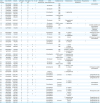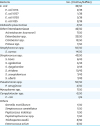1. Bradley A. Bovine mastitis: an evolving disease. Vet J. 2002; 164:116–128.

2. Tripaldi C, Palocci G, Miarelli M, Catta M, Orlandini S, Amatiste S, Di Bernardini R, Catillo G. Effects of mastitis on buffalo milk quality. Asian-Australas J Anim Sci. 2010; 23:1319–1324.

3. Asai K, Kai K, Rikiishi H, Sugarawa S, Maruyama Y, Yamaguchi T, Ohta M, Kumagai K. Variation in CD4 T and CD8 T lymphocyte subpopulation in bovine mammary gland secretions in bovine mammary gland secretions during lactating and non-lactating periods. Vet Immunol Immunopathol. 1998; 16:51–61.
4. Radostits OM, Gay CC, Hinchcliff KW, Constable PD. Veterinary Medicine: a Text Book of the Diseases of Cattle, Horses, Sheep, Pigs and Goats. New York: Elsevier Saunders;2007.
5. Duarte CM, Freitas PP, Bexiga R. Technological advances in bovine mastitis diagnosis: an overview. J Vet Diagn Invest. 2015; 27:665–672.

6. Royster E, Wagner S. Treatment of mastitis in cattle. Vet Clin North Am Food Anim Pract. 2015; 31:17–46.

7. Preethirani PL, Isloor S, Sundareshan S, Nuthanalakshmi V, Deepthikiran K, Sinha AY, Rathnamma D, Nithin Prabhu K, Sharada R, Mukkur TK, Hegde NR. Isolation, biochemical and molecular identification, and in-vitro antimicrobial resistance patterns of bacteria isolated from bubaline subclinical mastitis in South India. PLoS One. 2015; 10:e0142717.

8. Galiero G. The control of environmental mastitis. Bubalus Bubalis. 2002; 1:26–28.
9. Moroni P, Sgoifo Rossi C, Pisoni G, Bronzo V, Castiglioni B, Boettcher PJ. Relationships between somatic cell count and intramammary infection in buffaloes. J Dairy Sci. 2006; 89:998–1003.

10. Guccione J, Cosandey A, Pesce A, Di Loria A, Pascale M, Piantedosi D, Steiner A, Graber HU, Ciaramella P. Clinical outcomes and molecular genotyping of Staphylococcus aureus isolated from milk samples of dairy primiparous Mediterranean buffaloes (
Bubalus bubalis). J Dairy Sci. 2014; 97:7606–7613.

11. Guccione J, Perreten V, Steiner A, Thomann A, Pesce A, Ciaramella P, Bodmer M. Role of Streptococcus plurianimalium in Mediterranean buffaloes (
Bubalus bubalis) with different udder health statuses. J Dairy Sci. 2016; 99:2945–2949.

12. Burton JL, Erskine RJ. Immunity and mastitis. Some new ideas for an old disease. Vet Clin North Am Food Anim Pract. 2003; 19:1–45.

13. Drayton DL, Liao S, Mounzer RH, Ruddle NH. Lymphoid organ development: from ontogeny to neogenesis. Nat Immunol. 2006; 7:344–353.

14. Hjelmström P. Lymphoid neogenesis: de novo formation of lymphoid tissue in chronic inflammation through expression of homing chemokines. J Leukoc Biol. 2001; 69:331–339.
15. Hogan JS, Gonzalez RN, Harmon RJ, Nickerson SC, Oliver SP, Pankey JW, Smith KL. Laboratory Handbook on Bovine Mastitis. Madison: National Mastitis Council, Inc.;1999.
16. Ruddle NH. Lymphoid neo-organogenesis: lymphotoxin's role in inflammation and development. Immunol Res. 1999; 19:119–125.
17. Aloisi F, Pujol-Borrell R. Lymphoid neogenesis in chronic inflammatory diseases. Nat Rev Immunol. 2006; 6:205–217.

18. Goc J, Fridman WH, Sautès-Fridman C, Dieu-Nosjean MC. Characteristics of tertiary lymphoid structures in primary cancers. OncoImmunology. 2013; 2:e26836.

19. Neyt K, Perros F, GeurtsvanKessel CH, Hammad H, Lambrecht BN; Neyt. Tertiary lymphoid organs in infection and autoimmunity. Trends Immunol. 2012; 33:297–305.

20. Wirsing AM, Rikardsen OG, Steigen SE, Uhlin-Hansen L, Hadler-Olsen E. Characterisation and prognostic value of tertiary lymphoid structures in oral squamous cell carcinoma. BMC Clin Pathol. 2014; 14:38.

21. Döpfer D, Nederbragt H, Almeida RA, Gaastra W. Studies about the mechanism of internalization by mammary epithelial cells of
Escherichia coli isolated from persistent bovine mastitis. Vet Microbiol. 2001; 80:285–296.

22. Taylor BC, Dellinger JD, Cullor JS, Stott JL. Bovine milk lymphocytes display the phenotype of memory T cells and are predominantly CD8+. Cell Immunol. 1994; 156:245–253.

23. Shafer-Weaver KA, Sordillo LM. Enhancing bactericidal activity of bovine lymphoid cells during the periparturient period. J Dairy Sci. 1996; 79:1347–1352.

24. Oviedo-Boyso J, Valdez-Alarcón JJ, Cajero-Juárez M, Ochoa-Zarzosa A, López-Meza JE, Bravo-Patiño A, Baizabal-Aguirre VM. Innate immune response of bovine mammary gland to pathogenic bacteria responsible for mastitis. J Infect. 2007; 54:399–409.

25. Park YH, Fox LK, Hamilton MJ, Davis WC. Suppression of proliferative response of BoCD4+ T lymphocytes by activated BoCD8+ T lymphocytes in the mammary gland of cows with Staphylococcus aureus mastitis. Vet Immunol Immunopathol. 1993; 36:137–151.

26. Sordillo LM. Factors affecting mammary gland immunity and mastitis susceptibility. Livest Prod Sci. 2005; 98:89–99.

27. Park YH, Fox LK, Hamilton MJ, Davis WC. Bovine mononuclear leukocyte subpopulations in peripheral blood and mammary gland secretions during lactation. J Dairy Sci. 1992; 75:998–1006.

28. Asai K, Komine Y, Kozutsumi T, Yamaguchi T, Komine K, Kumagai K. Predominant subpopulations of T lymphocytes in the mammary gland secretions during lactation and intraepithelial T lymphocytes in the intestine of dairy cows. Vet Immunol Immunopathol. 2000; 73:233–240.

29. Mallard BA, Dekkers JC, Ireland MJ, Leslie KE, Sharif S, Vankampen CL, Wagter L, Wilkie BN. Alteration in immune responsiveness during the peripartum period and its ramification on dairy cow and calf health. J Dairy Sci. 1998; 81:585–595.

30. Maiolino P, Ozkul A, Sepici-Dincel A, Roperto F, Yücel G, Russo V, Urraro C, Lucà R, Riccardi MG, Martano M, Borzacchiello G, Esposito I, Roperto S. Bovine papillomavirus type 2 infection and microscopic patterns of urothelial tumors of the urinary bladder in water buffaloes. BioMed Res Int. 2013; 2013:937918.

31. Lucy MC, Evans TJ, Poock SE. Lymphocytic foci in the endometrium of pregnant dairy cows: characterization and association with reduced placental weight and embryonic loss. Theriogenology. 2016; 86:1711–1719.

32. Takemura S, Braun A, Crowson C, Kurtin PJ, Cofield RH, O'Fallon WM, Goronzy JJ, Weyand CM. Lymphoid neogenesis in rheumatoid synovitis. J Immunol. 2001; 167:1072–1080.

33. Coronella JA, Spier C, Welch M, Trevor KT, Stopeck AT, Villar H, Hersh EM. Antigen-driven oligoclonal expansion of tumor-infiltrating B cells in infiltrating ductal carcinoma of the breast. J Immunol. 2002; 169:1829–1836.

34. Murakami J, Shimizu Y, Kashii Y, Kato T, Minemura M, Okada K, Nambu S, Takahara T, Higuchi K, Maeda Y, Kumada T, Watanabe A. Functional B-cell response in intrahepatic lymphoid follicles in chronic hepatitis C. Hepatology. 1999; 30:143–150.

35. Barone F, Gardner DH, Nayar S, Steinthal N, Buckley CD, Luther SA. Stromal fibroblasts in tertiary lymphoid structures: a novel target in chronic inflammation. Front Immunol. 2016; 7:477.

36. Junt T, Scandella E, Ludewig B. Form follows function: lymphoid tissue microarchitecture in antimicrobial immune defence. Nat Rev Immunol. 2008; 8:764–775.

37. Buckley CD, Barone F, Nayar S, Bénézech C, Caamaño J. Stromal cells in chronic inflammation and tertiary lymphoid organ formation. Annu Rev Immunol. 2015; 33:715–745.

38. Sordillo LM, Shafer-Weaver K, DeRosa D. Immunobiology of the mammary gland. J Dairy Sci. 1997; 80:1851–1865.











 PDF
PDF Citation
Citation Print
Print



 XML Download
XML Download